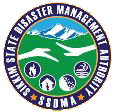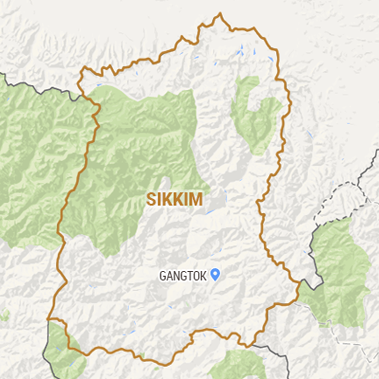GoI-UNDP Programme
Annexure
I
A
note on GOI-UNDP project on Enhancing Institutional and Community Resilience to
Disasters and Climate Change (2013-2017)
BACKGROUND:
GOI-UNDP project on “Enhancing
Institutional and Community Resilience to Disasters and Climate Change
(2013-2017)” would provide technical support to strengthen capacities of
government, communities and institutions to fast-track implementation of the
planning frameworks on Disaster Risk Reduction and Climate Change Adapxation.
The project with an overall budget of US$ 6.117 million will be implemented in
10 states viz Assam, Andhra Pradesh, Himachal Pradesh, Jharkhand, Kerala,
Maharashtra, Orissa, Sikkim, Tripura and Uttarakhand. In total, 25 districts,
10 cities and 10,000 villages would be targeted over a during the project
duration.
KEY STRATEGIES:
· Provide
substantive high-level national and international technical expertise on DRR
and CCA (Risk Assessment, Establishment of Early Warning Systems, strengthening
techno-legal frameworks for DRR, Design and implementation of mitigation
activities, etc.), also linked to local knowledge
· Provide
high quality expertise to help mainstream DRR as per the Twelfth Five Year Plan
· Build
capacities by working with training institutions that can in turn deploy
trainers/ resource persons to the sub-district level
· Develop
capacities of select vulnerable communities to enhance their resilience to cope
with disasters and climate variability, with government’s support
· Promote
systematic collection, storage and analysis of data as well as sharing of
learning and experiences through knowledge management initiatives by setting up
of a Knowledge Management Centre at the national level. This centre will work
in close collaboration with UN-Solution Exchange Network.
KEY PROJECT COMPONENTS:
1) Mainstreaming
DRR and CCA in Development Planning
The
process of mainstreaming DRR and CCA into development planning is impeded due
to a lack of appropriate tools and methodologies. With a view to address risk
reduction concerns and to facilitate mainstreaming of DRR/CCA in various
developmental sectors, the project will target atleast four key National
Flagship Development Programmes. Appropriate entry points, programme-specific
guidelines for mainstreaming as well as capacity building of government and
non-governmental functionaries involved in implementation of such programmes
will be developed.
2) Urban
Risk Reduction
UNDP will
continue its support in the area of urban risk reduction, following an
institutional approach. It will be providing technical assistance to strengthen
the governance structure for disaster risk management in select municipal
councils and corporations, train municipal government officials, and emphasize
inclusion of risk reduction in development projects. Technical assistance will
be provided in the following areas:
a) Hazard Risk and
Vulnerability Assessment
b) Strengthening of Early Warning
Systems
c) Capacity building at the
community level on disaster preparedness
d) Development of sectoral plans
to integrate DRR and CCA
e) Preparation of multi
hazard City Disaster Management Plans
3) Technical
Assistance and Capacity Building
a) Provision of Technical Assistance
through a Pool of Experts:UNDP
would provide technical assistance in the area of risk assessment, mitigation
planning, adapxation-risk reduction linkages, urban risk reduction and
communications network to the Government of India or State Governments on a
need basis, from a pre-selected pool of national and international experts.
b) Strengthening
of select Training Institutions across project states and organising sector
specific Training of Trainer’s Programme: UNDP will supportstrengthening of the
capacity of a few Training Institutions (pertaining to training on DM) by
upgrading the training facilities which will include conduct of training needs
assessment; and review and development of training modules, course curriculum,
and training materials; and support to design and conduct Training of Trainer’s
Programme on areas such as mainstreaming DRR, CCA-DRR linkages, post
disaster recovery, Post Disaster Damage and Need Assessment (PDNA), urban risk
reduction, etc.
4) Support for Knowledge
Management
a) Knowledge
Management Centre: UNDP will support establishment of a state-of-the-art
Knowledge Management Centre at the national level which will facilitate
systematic collection, storage and analysis of disaster data and also serve as
the platform for sharing of knowledge and experiences among the DM
practitioners. In addition, it would also provide learning facilities and
function as a repository of various knowledge products in the field of Disaster
Management developed by various stakeholders including state governments.
b) Research
Studies: Specific studies in relation to disaster risk reduction and
disaster resilience in India will be conducted to build the existing knowledge
base on disaster risk reduction. Emphasis will be laid on assessment of the
capacities and strengths that exist in relation to risk assessment, early
warning systems, disaster financing, recovery, preparedness and response.
c) Knowledge
Events: At least one knowledge event will be organized every year to
showcase the achievements made in relation to DRR.
d) South-South
Cooperation: The project will promote South-South cooperation through
collaborative studies, exchange visits, and workshops involving practitioners
from countries in the South Asian region and beyond.
5) Enhancing
resilience of vulnerable communities to cope with disasters and climate
variability by implementing scalable demonstrative pilot initiatives.
Under the project, efforts will be
made to enhance the resilience of select vulnerable communities living in
coastal, rainfed area, deltas and wetlands, inland water bodies, river plains,
and hilly regions to cope with disasters and climate variability by implementing
scalable demonstrative pilot initiatives. Measures for mitigating
the impacts of disasters and climate change will be implemented by designing
community led pilot initiatives. Some of the proposed pilot initiatives are as
follows:
a) Integrated
Water Management for Climate Change Adapxation and Disaster Risk Reduction: This
will include measures such as revival of traditional water bodies, demand side
ground water management, aquifer mapping, recharge of ground water, increased
efficiency in utilization of water for the purpose of irrigation and domestic
use, de-water logging/drainage decongestion, and land reclamation in flood
plains, deltas and coastal plains.
b) Construction
of safe shelters:The project will attempx to pursue CCA-DRR linkage in the
shelter sector. It will assess the vulnerability of select communities from
disasters and climate change and work with home-owners to introduce
hazard-resistant building technology, climate sensitive designs, use of
appropriate building materials, adequate provision for water and sanitation in
the habitat design/planning, incorporation of water harvesting measures, use of
energy efficient devices for electricity, and disaster preparedness through
suitable structural and non-structural measures.
c) Alternative
livelihoods and Livelihood Diversification for Adapxation and Resilience
Building: Efforts would be made to develop expand the livelihood opxions
through skill development of women groups and expansion of local economic
activities through diversification, strengthening of local markets,
infrastructure and promoting insurance. There will be special emphasis on
climate change adapxive water and land based crop systems and farming
practices. The project will attempx to promote financial inclusion by
strengthening self-help groups, and establishing linkages with microfinance
organizations.
d) Community
level early warning systems: The project will attempx to develop mechanisms
to ensure access to early warning information by the communities at risk.
Appropriate technologies would be identified and promoted through existing
programmes to establish effective early warning systems.
e)Participatory
Risk Assessment:The project will attempx to promote community level
participatory risk and vulnerability assessments using both indigenous
knowledge and geospatial technologies such as satellite imagery, remote
sensing, Global Positioning and Geographical Information Systems. Also,
attempxs would be made to demonstrate how community concerns can be integrated
and addressed in development plans through such participatory risk assessments.
PROJECT MANAGEMENT AND IMPLEMENTATION ARRANGEMENTS:
At National Level: The Ministry of Home Affairs will be the Implementing Partner for
the project, and will be responsible and accountable for the effective use of
UNDP (and other) resources and the achievement of the project outcomes and
outputs. A work plan on an annual basis outlining activities and
corresponding budgets will be prepared in consultation with the MHA and signed
between MHA and UNDP as per UNDP rules and regulations. Selected state governments
(State Disaster Management Authorities) will be responsible parties to
implement the project activities by signing Work Plans on an annual basis with
the MHA. The state governments/SDMAs will be responsible for carrying out
project activities at state, district, city and local levels.
The Project Management Committee (PMC): Project Management
Committee (PMC) constituted by the Ministry of Home Affairs (MHA) will meet at
least once a year, and will have state governments as members to provide
oversight and cross-Sectoral linkages. The PMC would be chaired by the
Secretary (Border Management).
State Monitoring Committee: The State Monitoring Committees
(SMCs) will be constituted and chaired by the Principal Secretaries, State
Revenue Department/CEO, SDMAs for implementation and monitoring of the Project.
The members of the Committee will include officers (at least of the rank of
Joint Secretary) from the relevant departments. The members may include
officers of State level Urban and Rural Development Department, Planning
Department, Metropolitan Authorities and other relevant departments, and
representatives of MHA and UNDP.
Technical Support: Considering the size, wide range of
Government/Non-Government organizations and stakeholders and spread of the
project over a large geographical area, a Project Management Team (PMT) within
the Ministry will be put in place for support in coordination and management of
the project. It will comprise of 3-4 technical experts and a support staff. At
the state level UNDP will engage a State project officer to support the
Department of Land/Revenue /Disaster Management /SDMA and liaison with
technical cooperating agencies such as UN agencies, NDMA, NIDM, any other
resource/research based institutions for fulfillment of the project
outcomes.
GOI-UNDP Disaster Risk Management Programme,
2002-2009
Implementing
agency : Ministry
of Home Affairs (MHA), Govt. of India
State agency : Land Revenue and Disaster Management
Department, Govt. of Sikkim
No. and name of the district selected : 4; East, West,
North and South
District headquarters: Gangtok, Geyzing, Mangan, Namchi
Ministry of Home Affairs with support from UNDP-India implemented the GoI-UNDP
Disaster Risk Management (DRM) Programme during the period 2002-2009. This
Programme came to an end on June 2009. The DRM programme aimed at reducing the
vulnerabilities of communities at risk to natural disasters in 176 multi hazard
prone districts across 17 States of India including Sikkim. The Programme had a
multi donor resources framework of $41 million and was the largest
community-based DRM programme in the world.
The main objectives of the programme were :
- Capacity
Building to institutionalize DRM Initiatives at National, State and Local
level.
- Creating awareness and strengthening capacities at districts,
blocks, panchayat and village levels on disaster risk management which
included preparation of multi-hazard preparedness, response and mitigation
plans, training of life saving skills like first aid, search and rescue
and fire fighting.
- Knowledge networking on effective approaches, methods and tools
for DRM.
- Supporting development of policy frameworks at the State and
National level on Disaster Management.
In a nutshell community capacity‐building was
one of the key components of the DRM programme. Community volunteers are often
the first responders to a disaster in real‐time, and the DRM programme
undertook widespread training of Community Volunteer, Civil Defence, Home Guard
and the Fire Service in Search and Rescue, First Aid, and Evacuation, Relief
and Shelter Management. Conducting mock drills at all levels was also a key
activity of the programme.
GOI-UNDP Disaster Risk Reduction Programme, 2009-2012
(Institutional Strengthening and Capacity Building for Disaster Risk Reduction)
Implementing agency : National Disaster Management Authority (NDMA), Govt.
of India
State agency : Land Revenue and Disaster Management Department,
Govt. of Sikkim
No. and name of the district selected : 4; East, West, North and South
District headquarters: Gangtok, Geyzing, Mangan, Namchi
Based on the past experiences gained during
the implementation of the GOI-UNDP DRM Programme 2002-2009 and the enactment of
Disaster Management Act 2005, and the various efforts undertaken by MHA, NDMA,
UNDP; it was felt necessary to take up more programmes to enhance the capacity
of the DM institutions set up at various levels for disaster risk reduction.
Hence after the successful implementation of
the GOI-UNDP Disaster Risk Management Programme (2002-2009), Government of
India with support from UNDP& NDMA, is implementing the GOI-UNDP Disaster
Risk Reduction Programme (DRR) from 2009 to 2012.
The GOI-UNDP DRR programme is envisaged to
support Central and State Government programmes and initiatives by providing
critical inputs that would enhance the efficiency and effectiveness of the
efforts in Disaster Risk Reduction. The programme strives to strengthen the
institutional structure to undertake Disaster Risk Reduction activities at
various levels including risks being enhanced due to climate change and develop
preparedness for recovery.
The Programme has two components :
- Institutional
Strengthening and capacity Building for Disaster Risk Reduction (DRR)
- Urban Risk
Reduction (URR)
DRR Programme specific outcomes are as follows :
- Strengthening
the State Disaster Management Authorities (SDMAs) and District Disaster
Management Authorities (DDMAs) to fulfill the responsibilities stipulated
in the DM Act (2005).
- Developing
methodologies and modalities for ensuring risk reduction through
integration in development programmes of all partners at national, state
and community levels.
- Enhancing the
capacity for urban risk reduction by addressing planning, capacity
building and ensuring suitable legislative and regulatory mechanisms to
promote safe built environment.
- To strengthen
the recovery framework, through which the people affected by disasters
(especially the most vulnerable) are able to access resources for
rebuilding their lives and reviving their livelihoods.
- To strengthen
Knowledge and information sharing platform in disaster management.
GOI-UNDP Urban Risk Reduction Programme, 2009-2012
Implementing agency : Ministry of Home Affairs (MHA), Govt. of India
State agency : Land Revenue and Disaster Management Department and
Urban Development Housing Department, Govt. of Sikkim
No. and name of the district selected : 1; Gangtok Municipal Corporation
Government of India, United Nations
Development Programme (GOI-UNDP) is currently implementing Urban Risk Reduction
Programme (URR, 2009-2012) covering 58 cities in India. The programme is being
implemented Ministry of Home Affairs, New Delhi in association with the United
Nations Development Plan. Gangtok, the state capital has been chosen for the
said programme.
The Programme will have the following
deliverables:
- Risk
Assessment and Disaster Risk Reduction for Urban Development Programmes
- Conduct urban
risk and vulnerability assessments
- Facilitate
integration of risk reduction into urban development programmes
- Capacity
building in Urban Risk Reduction
- Strengthen
enforcement of building codes, by‐laws and development control regulations
- Training and
capacity‐building for safer construction practices and urban planning
- Institutional
Strengthening for Urban Risk Management
- Strengthened
institutional capacity
- Strengthened
disaster response capacity for city level
- Urban
Community‐based Disaster Risk Reduction
- Urban
Community-based Disaster Risk Management
- Access to
local level financial mechanisms for DRM
Some of the key areas of work as identified
are as follows:
Generating Awareness Generation in urban areas
of India on Disaster Risk Reduction through the use of City Managers Forum,
Mayors Forum and community-based networks established by the Ministry of
Housing and Urban Poverty Alleviation in collaboration with National Resource Centers.
- Mainstreaming
Disaster Risk Reduction into policy, plans and programmes at the state and
Urban Local Bodies level.
- Promoting
incorporation of hazard resistant technologies in housing and basic urban
infrastructure plan at the city level.
- Preparation of
Hazard Risks and Vulnerability Atlas for selected multi hazard prone
cities.
- Training and
capacity building on improved governance arrangements at the city level
for Disaster Response and preparedness.
- Preparation of
Disaster Risk Mitigation Plan in selected cities and their integration
into the overall City Development Plans on pilot basis.
- Capacity
building of vulnerable communities in selected multi hazard prone cities
on disaster preparedness and response.
- Bringing in
amendments in building byelaws, Land use zoning regulations Development
Control Regulations/ Town and County Planning Act in various states to
ensure structural safety against natural hazards and strengthening the
mechanism for compliance to it.
- Training and
capacity building of engineers and architect and masons in selected cities
on hazard resistant construction practices.
- Strengthening partnerships with various institutions of Urban Management for building capacity of various stakeholders on urban disaster risk reduction.





